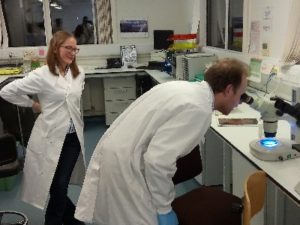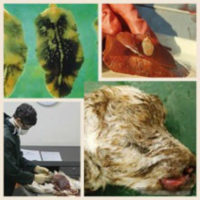New Entrants to Farming: Do you know what happens at the vet lab after you drop off a sample or carcass? – event summary
21 February 2017This meeting was targeted towards New Entrants to farming and was only suitable for those who had a strong stomach, were over 16 years old and not pregnant! Despite the restrictions, a number of people arrived to listen to SRUC Veterinary Services Vets – investigation officers Heather Stevenson & Katrina Henderson.
The evening began with a brief health & safety talk, followed by a presentation from the vets on disease surveillance, ovine abortion and calf scours.
After the classroom part of the evening was concluded, the new entrants were split into two groups for the practical session. The lab session began with a look at various disease causing bacteria under the microspore and a brief chat about fluke, while viewing sample tubes containing  mud snails (an essential part of fluke life cycle) and fluke at varying ages.
mud snails (an essential part of fluke life cycle) and fluke at varying ages.
The group then moved down to the post mortem room to see a calf being post-mortemed. It was a first time experience for all in the group and the best piece of advice given was to breathe through your mouth and not your nose!
You can read Heather Stevenson’s presentation slides (containing graphic images) on Lamb losses can be viewed here and Katrina Henderson’s presentation on Calf Scour is summarised here.
Key points from the meeting
- SAC Veterinary Services offer a wide range of services, including post mortem examinations; diagnostic testing; investigating emerging diseases; planned approaches to herd health and disease surveillance.
- It can be a good idea to bring in a live specimen e.g. poor doing sheep, to best diagnose a health problem- don’t always wait for an animal to die.
- Calf scours- prevention is better than cure. Try to maximise calf immunity (colostrum management, vaccination of the dam, clean dry environment, avoid lots of stress at once) and limit exposure to infectious agents (clean & disinfected calving facilities).
- There are numerous causes of scour, most have the same or similar risk factors. Diagnosis of scour is not just what organism is causing it- consider how the organism spreads and how you can prevent it.
- Enzootic Abortion (EAE) and Toxoplasma combined account for 50% to 65.7% of abortion diagnoses made. The annual cost to industry is: EAE £20 million & Toxoplasmosis £ 12 million. *Vaccination is recommended*
Sign up to the FAS newsletter
Receive updates on news, events and publications from Scotland’s Farm Advisory Service

